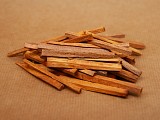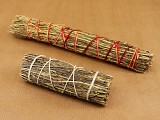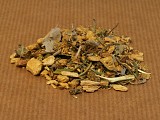Wood, Chips, 25 Gr from Peru (SKU 5460)
Palo Santo, known as “Holy Wood,” has been revered for centuries by indigenous communities across South America. Shamans and healers have traditionally used the wood’s smoke to cleanse spaces, dispel negative energies, and create a tranquil, grounded atmosphere. Burning Palo Santo grains releases a rich aroma that invites peace, clarity, and focus. For spiritual practitioners, Palo Santo’s smoke symbolizes renewal and transformation, creating a “spiritual cleanse” that gently removes stagnant energies, bringing balance and positive vibrations into the space. This is excellent quality resinous wood, ideal for subtle application of this powerful incense on Charcoal Tablets, or as an ingredient in your personal blends.
Cut and sifted grains (3-5 mm) of resinous Palo Santo wood, 25 gram.
| change currency | |||||||||
| SKU | Part | Form | Weight | Unit | Price | Qty
|
|||
|---|---|---|---|---|---|---|---|---|---|
| 5460 | wood | chips | 25 gr | 1 pc | $ 2.52 | ||||
| 3539 | wood | chips | 50 gr | 1 pc | $ 4.72 | ||||
| 4075 | wood | chips | 100 gr | 1 pc | $ 8.82 | ||||
| 5461 | wood | chips | 250 gr | 1 pc | $ 20.15 | ||||
Cut and Sifted Palo Santo Grains – Premium Quality for Charcoal and Incense Blends
Bring the sacred essence of Palo Santo into your spiritual practices with our cut and sifted Palo Santo grains, carefully prepared for those seeking the grounding, purifying aroma of Palo Santo in a versatile format. These grains are specially cut and sifted to a consistent grain size of 3-5 mm, ensuring a smooth, controlled burn that is ideal for use on charcoal or as part of coarse incense blends. Perfect for ceremonial and personal use, these grains deliver the rich, woody aroma of Palo Santo in its most adaptable form.
Sustainably Sourced and Naturally Aged Wood
Each grain is sourced responsibly from Palo Santo trees that have naturally fallen and aged on the forest floor. Over 4 to 10 years, the wood undergoes a natural transformation that concentrates resins and enhances its fragrance, creating a deeply aromatic and spiritually potent product. By choosing these Palo Santo grains, you support ethical and sustainable harvesting practices that protect living trees and preserve dry tropical forests in South America, particularly in Ecuador and Peru. These sustainable practices help to maintain the sacred and ecological value of Palo Santo for generations to come.
Consistent Grain Size for Reliable and Balanced Burning
Our cut and sifted Palo Santo grains are uniform in size, providing a steady, balanced burn. This consistency enhances their usability on charcoal and in incense blends, allowing for an even release of Palo Santo’s calming aroma. Unlike larger pieces, which can burn unpredictably, the uniform grain size ensures a controlled burn that releases a steady stream of the sweet, woody, and citrusy fragrance unique to aged Palo Santo. This makes these grains particularly well-suited for rituals, meditation sessions, or any setting that benefits from a consistent and smooth release of aroma.
Deep Cultural and Spiritual Significance
Palo Santo, known as “Holy Wood,” has been revered for centuries by indigenous communities across South America. Shamans and healers have traditionally used the wood’s smoke to cleanse spaces, dispel negative energies, and create a tranquil, grounded atmosphere. Burning Palo Santo grains releases a rich aroma that invites peace, clarity, and focus. For spiritual practitioners, Palo Santo’s smoke symbolizes renewal and transformation, creating a “spiritual cleanse” that gently removes stagnant energies, bringing balance and positive vibrations into the space.
These Palo Santo grains bring this sacred wood’s spiritual power into your daily practices, whether for personal cleansing, meditation, or sacred rituals. Their gentle, steady smoke is ideal for those seeking a balanced, centering atmosphere that fosters introspection, peace, and harmony.
Versatile Applications for Cut and Sifted Grains
These Palo Santo grains offer multiple uses to meet a variety of spiritual and wellness needs, providing flexibility and convenience:
Charcoal Burning: Sprinkle a small amount of grains onto a lit charcoal disc to release their aroma. This method allows the grains to burn evenly, making them ideal for creating a serene and grounded environment during meditation, yoga, or ceremonial work.
Coarse Incense Blends: Integrate the grains into your incense mixes, pairing them with complementary herbs, resins, and flowers. Their consistent grain size makes them an excellent addition to coarse incense blends, where they can contribute a distinctive, layered aroma.
Morning and Evening Cleansing Rituals: Start or end your day with a simple ritual by burning a small amount of grains on charcoal. This practice is believed to clear stagnant or heavy energy from personal spaces, offering a sense of renewal and calm.
The Therapeutic Properties of Palo Santo
The grains contain the essential aromatic compounds responsible for Palo Santo’s unique therapeutic qualities:
d-Limonene: Known for its uplifting, citrusy scent, this terpene enhances mental clarity, lifts the mood, and creates a sense of calm.
Alpha-terpineol: Adds a soothing floral note to the aroma, contributing to Palo Santo’s calming and grounding effects.
Carvone: Provides a subtle minty undertone, adding depth and freshness to the fragrance.
These compounds contribute to the wood’s balancing effects, which support emotional well-being, encourage a positive mindset, and promote spiritual clarity. By incorporating these Palo Santo grains into your routine, you can experience the unique blend of relaxation and focus that has made Palo Santo a staple in traditional wellness practices for centuries.
Key Features and Benefits
Sustainably sourced from naturally aged, fallen Palo Santo wood
Consistent grain size for even burning and balanced aromatic output
Perfect for use on charcoal or in coarse incense blends
Delivers the authentic, sacred fragrance of Palo Santo for cleansing and grounding
Ideal for spiritual practices, energy balancing, meditation, and personal wellness rituals
Conclusion: Transform Your Space with Sacred Palo Santo
Palo Santo grains provide a practical, versatile way to incorporate the sacred essence of Palo Santo into your daily life. Perfectly sized for controlled, even burning, they release the wood’s full aromatic profile and support a range of spiritual practices—from meditative rituals to cleansing ceremonies. Whether used alone or as part of an incense blend, these grains offer a convenient, meaningful way to enjoy Palo Santo’s profound spiritual and therapeutic benefits, all while honoring its ancient legacy.
For those who love to experiment with the alchemy of combined scents, Palo Santo goes very well with the following incenses: Sweetgrass (Hierochloe odorata), White Sage (Salvia apiana) and Copal (Dacryoides peruviana).
An extensive article on the Palo Santo tree and it's uses can be found here.
Disclaimer
The information provided above is for historical, educational, and scientific purposes only. It should not be interpreted as a recommendation for the specific use of our products. Any statements about traditional uses are informational. The use and application of our products are the customer's decision and responsibility.
Copyright Notice
All content, including this article, is protected under copyright law. Any unauthorized reproduction, distribution, or use of this material is prohibited. Duplication of this content, in whole or in part, without written consent, is a violation of copyright regulations.
Other names: Bursera graveolens, Sisaya, Palo de la vida o Santo, Madeira Sagrada, Sacred Wood, Holy wood, St. Anthony`s wood, Palosanto, Malka Waki.
This item is not allowed in the following countries:
Taiwan
This is a natural product, used as incense or in perfumery, or as an ingredient of incense and other perfumery or potpourri preparations.
Some incense plants or products may have some history of other folklore purposes, but we offer this product for its use as incense. Not food grade, not for consumption.
Please read our Terms & Conditions before placing your order.

























